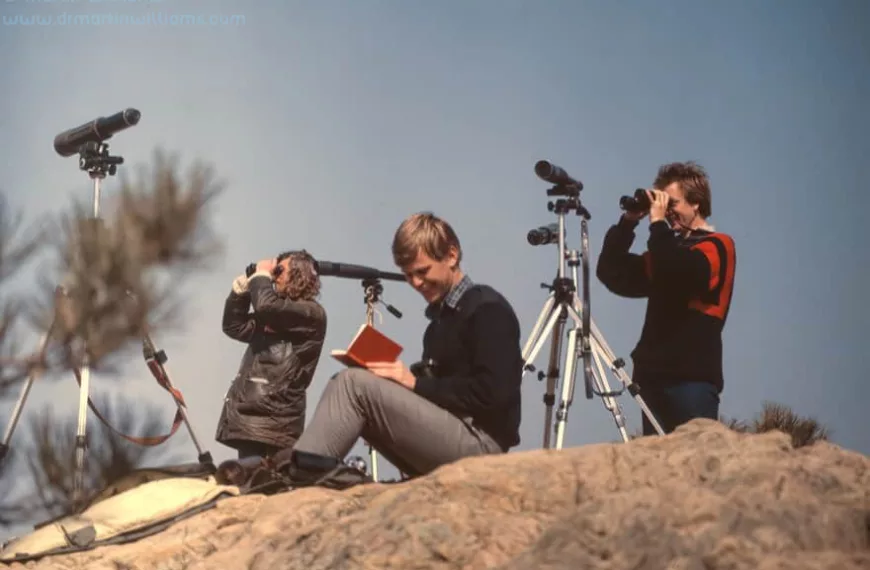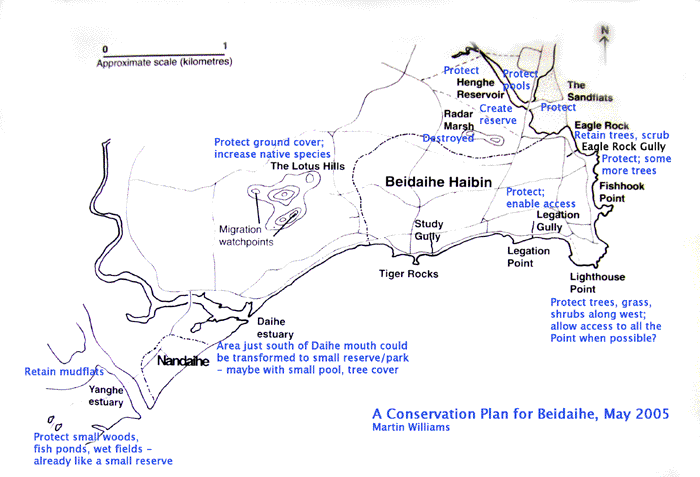Summary
I first visited Beidaihe in spring 1985, leading a migratory birds survey that helped put the town on the “global birdwatching map” as a major hub for migratory birds. I have returned many times since, leading more surveys, co-leading birdwatching tours; and advocating for conservation.
Here, a few notes based on a return visit in May 2024, kindly supported by the Beidaihe government.
Brief summary: of course, much has changed at Beidaihe since 1985, and while protection of the wetland by Pigeon Nest (Eagle Rock) is welcome, several changes are negative, significantly reducing Beidaihe’s appeal for birdwatching. Ongoing negative impacts could lead to Beidaihe being a great place for birds only in historical records; to me, would be so sad, a great waste.
However, opportunities for improvements remain; there is still a chance to create one of the world’s most exciting reserves for migratory birds, as I said back in 2009.
Changes since 1985
Of course, much has changed since spring 1985. Yet not all the changes seem essential with economic development: for instance, the tidal flats at the Yanghe estuary are now very poor for birds; several of the small gullies along the south coast of the town are inaccessible; and the north shore of the sandflats by Pigeon Nest has been destroyed, with significant concreting replacing the former wetland areas here.
On the plus side, Olympic Park is new, and attracts songbirds; and an extensive area of the Pigeon Nest sandflats is protected as a reserve; the area to the west of this has also been safeguarded from significant construction, though a Wetland Park has too much woodland, too little wetland.
Opportunities
There are multiple opportunities for improvements. Especially at Pigeon Nest sandflats, where some landscaping could attract more birds; and – very importantly – suitable visitor facilities could enable very many people to experience the wonderful birds of Beidaihe.
Wuwei 无为
In Taoism, the principle of wuwei has long been important. Not sitting doing nothing!; but acting in harmony with nature. By seeking to understand nature – such as what kinds of wetland habitats suit certain birds – and acting accordingly, the reserve can be enhanced, helping Beidaihe become a place bringing people and migratory birds together, for the benefit of both.
The reserve can become a significant, lasting attracting, leveraging Beidaihe’s unique advantages as a mega migratory bird hub plus hugely popular resort town.
Plus, create and improve wetlands where appropriate; likewise woodland in areas suiting woods.
Changes Reducing Beidaihe’s Appeal for Migratory Birds
With hindsight, we were fortunate in 1985 that the main places Axel Hemmingsen had recorded birds from 1942-1945 were still present; and there were more sites for us to discover in and near the town. All these sites were within cycling distance; contrast nowadays – such as the Birdwatching Competition in May 2024, when many of the birds seen were recorded at other places, tens of kilometres away.
This decline in Beidaihe as a place for birdwatching has been noted for several years; and it is perhaps reaching something like a point of no return – it would not take much more habitat loss and damage for Beidaihe to become a has-been birdwatching destination, a place visiting birdwatchers would want to spend little time, or simply ignore in preference for more rewarding locales. This is not inevitable; see later for ways to reverse the decline, reinvigorate Beidaihe for birding.
Perhaps it’s not comfortable starting this way; but it’s surely important to assess the actual situation, and then develop a strategy for moving forward.
So, what are some of the negatives? Some examples here.
Yanghe Estuary

Previously, the tidal flats of the Yanghe estuary – pictured above in autumn 1987 – attracted fair numbers of wetland birds, notably shorebirds such as sandpipers and plovers.
Even after the first road bridge was built, along with buildings constructed nearby, it remained a worthwhile place to stop and look for these birds.

However, in recent years the estuary has become more akin to a dead zone for birdlife; I’m not too sure why. Perhaps some dredging, to help fishing boats; construction rubble dumped in the shallows [from demolition of the first Yanghe bridge??]; pollution? A combination of these factors? I’m not sure.
Daihe Pool

This was a small, wonderful and short-lived birdwatching hotspot. It was just a small pool, maybe resulting from sand/gravel extraction south of the Daihe mouth – and though maybe just several tens of metres in diameter, it had muddy shallows that attracted an excellent variety of waterbirds, especially shorebirds, during spring 1985. It had been filled in when we returned in 1986; a sad loss to us.
Today, there are similar pools at Stone River South Island, Shanhaiguan – likewise showing that even seemingly simple wetlands can host good densities of migratory waterbirds.
West Hill Gully, Study Gully, Legation Gully
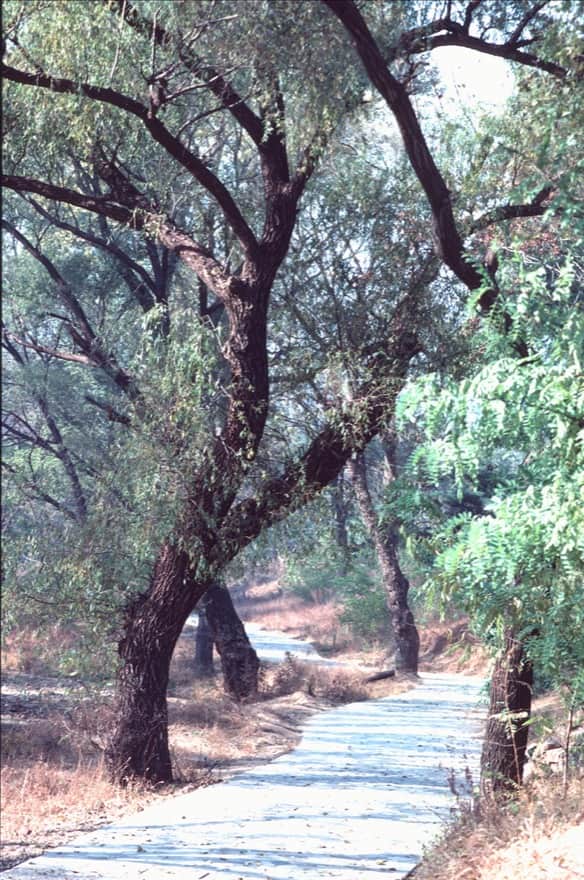
From 1985 to the 1990s, there were several pleasant gullies – small valleys – with trees and bushes, which were pleasant places to watch a variety of songbirds. Above is West Hill Gully in the Lotus Hills, and is Legation Gully; both were also known by Hemmingsen.
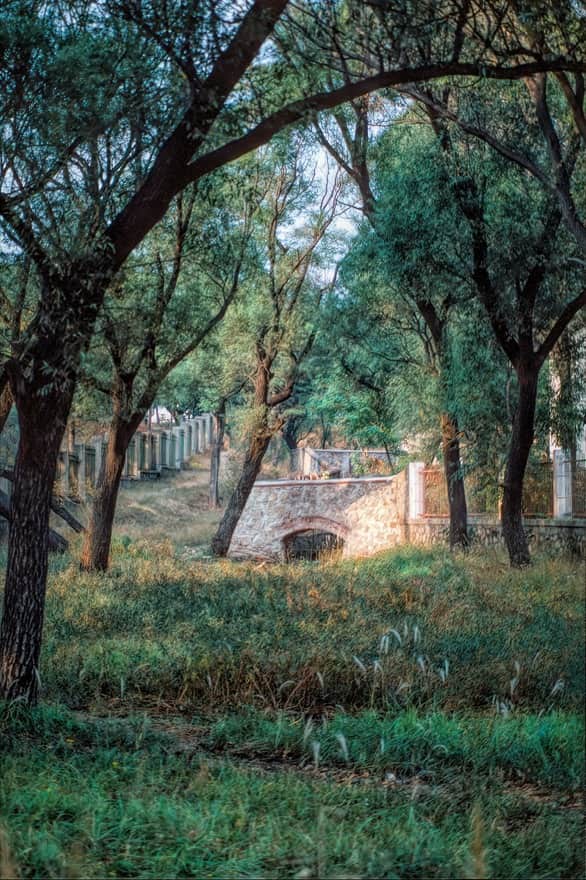
Over the years since, there have been developments including housing that have reduced their attractiveness to birds, plus several are now off-limits or restricted to visitors.
Lighthouse Point = Jin Shan Mouth
Though a naval facility occupies the southeastern peninsula of Beidaihe – which Hemmingsen called Lighthouse Point, but is locally known as Jin Shan Mouth – it seems this is not a major high security base, and for several years it was possible to walk along the west shore of the headland, to the southern tip.

Thanks to its location, this was an excellent place to observe migrants arriving from and passing over the sea; plus the trees near the path could hold good numbers of songbird migrants, making for some exciting birdwatching.
There were changes over the years, including removal of some vegetation; but by May 2024 even the west shore path was within a restricted area, making one of Beidaihe’s prime birdwatching hotspots inaccessible to birdwatchers.
Fishhook Point

This was a pleasant place to visit, away from the main swimming beaches, with fine coastal scenery, and a chance of interesting migrants, albeit not a key Beidaihe hotspot.

And now, there’s something like a theme park, with “Snail Tower” and more; looks like the scenery has been carelessly ruined. Ah well, of course not all Beidaihe visitors are nature lovers….
Pigeon Nest Park, Eagle Rock and the Sandflats

The Sandflats north of Eagle Rock – as Hemmingsen called them, and we followed these names – was one of Beidaihe’s prime birdwatching areas, pictured here in autumn 1987. Many waterbirds occurred on the tidal flats, especially in autumn; others rested and fed on the sea offshore.
Plus many birds overfly this area; which helped make Eagle Rock itself an excellent vantage to watch for visible migration including cranes, birds of prey and songbirds.

Above, in May 2024: few or no actual birds in view, just photos along a fence. The steep, artificial sides of a channel make it of about zero value for birdlife.

A romantic stroll, with no wetland or wetland birds in view; and (in 2019) a concrete expanse where there was some wetland before, plus a bird museum not a visitor centre.
Well, the southern shore of the Sandflats has been destroyed, making way for a variety of artificial things like a car park, a bird museum [in English, “museum” is more associated with dead animals etc, unlike a visitor centre for a living reserve], theme park like elements, and a path with few actual birds in view but many photos of birds along a fence. There are also a channel and a pond with steep concrete/rock sides – about useless for birdlife.

These highly artificial areas are part of/adjoin the Beidaihe Pigeon Nest Wetland reserve, and make this a very, very strange wetland reserve.
It seems that planners/developers did not really like the idea of having a wetland reserve, so created a wide range of artificial areas, perhaps believing nature is not in itself worthwhile, and could not attract visitors. Which is a point of view for debate, of course; but does not fit with experiences worldwide, nor with information such as “The Geziwo [Pigeon Nest] Beach is a world-famous bird watching destination.”
Why such a lack of respect for and pride in the reserve here? See later, for ideas for changes; but if the Pigeon Nest Wetland continues like this, it will be world famous more as an example of how to ruin a birdwatching hotspot.

Yes, much of the Sandflats remains, protected in a simple manner – by being fenced off to prevent public access. This is notable of course in an area that could have been developed, with high land and property prices; and without this reserve we would surely say Beidaihe as a birdwatching place had become extinct, finished, kaput. Yet the reserve is neglected; and see here the artificial, rocky south shoreline that has no benefits for birds. Is this really the best that is possible here? [Answer: No!]
Xinhe = Henghe reservoir surroundings – Beidaihe Wetland Park


In 1985, we arrived to find a slender reservoir had been created inland of the Sandflats, along a river Hemmengsen had called the Henghe, but more recently called the Xinhe. This was, we learned, to store water for irrigating the adjoining rice fields. The land on either side was flat, with some remaining rice fields, plus abandoned fields that had become marshes – attracting a high variety of freshwater wetland birds.

The Henghe/Xinhe reservoir area was a very pleasant place to walk around, even on days with few birds. Above left, rice planting in spring 1985. Above right, a boat on a channel very near the bridge along the Beidaihe to Qinhuangdao higway. To me, wetland landscapes and environments are very appealing, not only for birds.


The above photos show marshes that formed one of Beidaihe’s key birdwatching localities. It appeared the area was exactly right for creating a freshwater wetland reserve; with reduced disturbance, and a little landscaping to improve and expand the marshes, it might attract some of the larger wetland birds to pass Beidaihe, such as storks, cranes and geese.
Indeed, in 1990 the Beidaihe government established a Natural Reserve for Birds here; though sadly did not have money for any work on the reserve.


More recently, a Wetland Park has been established to the north of the reservoir. The words “wetland park” suggest this would be a positive development; yet I have only been once, in May 2019, and found this “wetland park” has actually involved destroying most of the wetland!!!
As in these photos, most of the wetland/open areas have been replaced by trees, and it is quite hard to find any actual wetland in the “Wetland Park”; even the areas that remain attract few wetland birds. The trees are not of a special species; nor is the woodland here special either – there is a large area of similar woodland extending northward from here to near Qinhuangdao.

Where’s the wetland?? [In the treetops?]
Online, there is an article telling of a visit to Beidaihe by Hank Paulson, “chairman of the Paulson Institute and a lifelong conservationist”. This includes the above photo of him visiting Beidaihe Wetland Park. Notice that no real attention is being paid to the “wetland” here – most people are looking up into trees; and Paulson, I believe it is, has hands in pockets, maybe wondering where the supposed wetland of the wetland park actually is, and why there are no wetland birds.
There’s also a big security gate at the entrance to the “wetland park”, which seems unwelcoming to visitors, maybe just for a few people to enjoy. On the south side of the reservoir, there are also trees but little wetland in sight, and a security guard made sure I could not have a look around there.
Mysterious Area with Water that is not a Park, and not a Reserve
In May 2024, I visited an area around 2km upstream of the Xinhe reservoir, which I found quite mysterious.
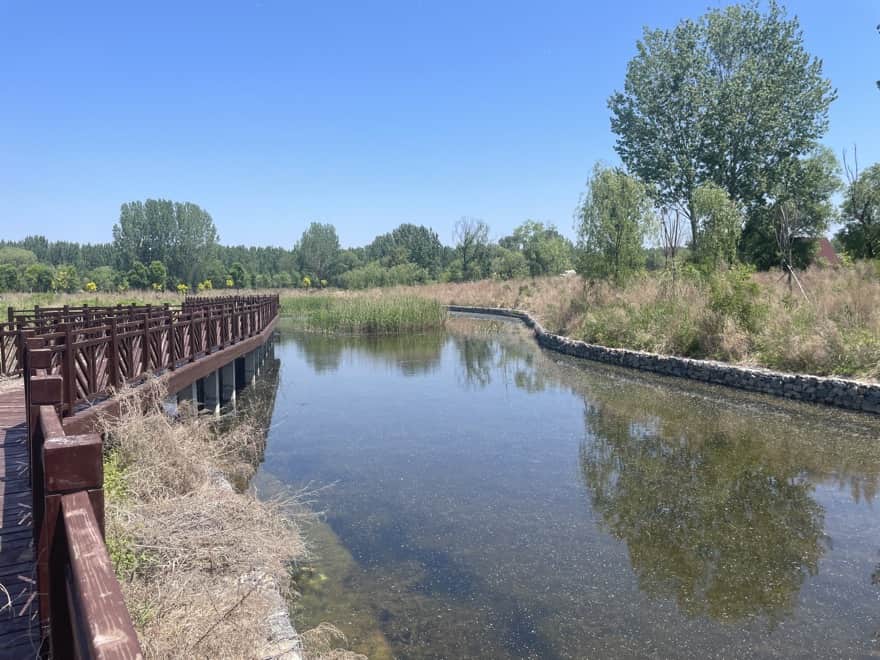
As in the above two photos, there were small artificial ponds, plus channels; with steep artificial sides making their margins useless for birds. Pipes circulated water from the adjacent Xinhe.
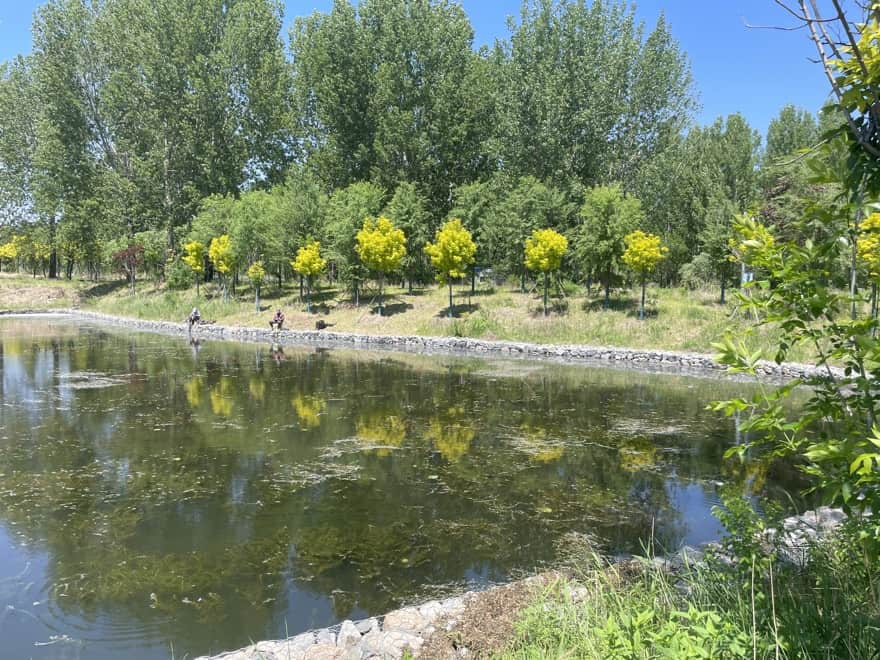
While a Schrenck’s Bittern flew out of the sparse reeds in one pond and I heard a couple of Black-browed Reed-Warblers singing, the ponds were otherwise birdless. There were, however, a couple of fishermen by one pond.
Given the ponds’ design, I figured this area could not have been created as a bird reserve. But though there were walkways, it was also not a public park, partly as it was hidden away and surely not of much interest to people either.
I was astonished to be told the area was created with the idea of attracting birds like cranes, and at considerable expense – tens of millions of yuan, unless my translation skills went very wrong. If true, this seems amazing indeed; and while above I mentioned wuwei 无为 – acting in harmony with and with an understanding of nature – this area seems to reflect the very opposite, with no real understanding of cranes and other birds, even though there are local experts willing to help.
Olympic Park: Welcome Addition to Beidaihe Birdwatching Sites
After all the above sites where Beidaihe’s value as a birdwatching hotspot has been reduced, a mention of a new site that is a good place for birds.
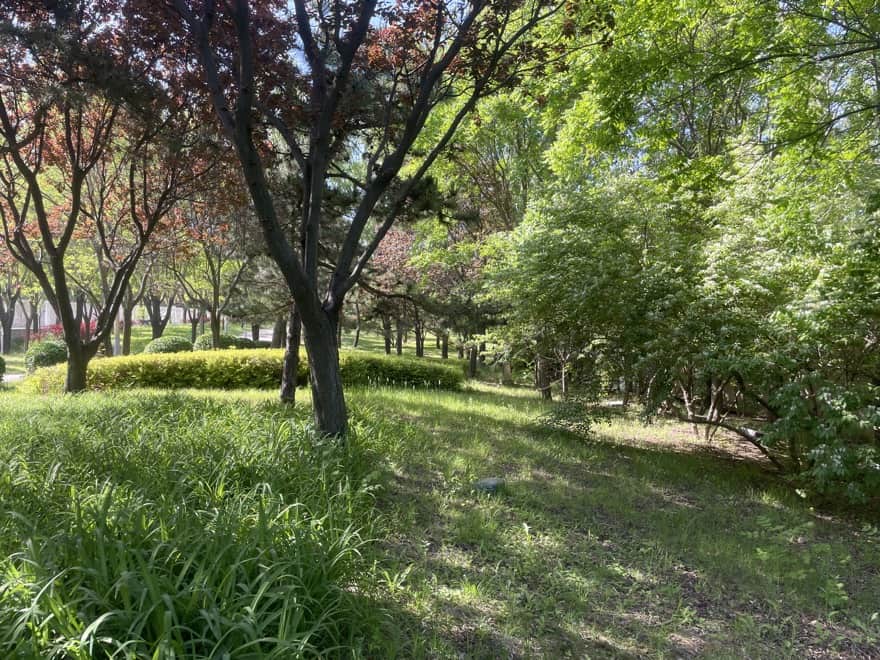
Olympic Park, lying a little south of the Pigeon Nest sandflats, is a pleasant urban park and – helped by not being too manicured so parts still look fairly natural – attracts songbirds such as flycatchers and robins. It isn’t a must visit locale on the China coast, but is well worth a look for anyone birdwatching in the Beidaihe area.
Potential Improvements to Beidaihe as a Birdwatching Destination – and, Who am I to Suggest Them?
Perhaps it just seems that I’m some British guy who turned up one day with some friends, and began watching birds at the town; and has reappeared several times since. And, yes, I have never designed a bird reserve.
Yet, on the plus side, I have been a dedicated birdwatcher since 1976, and over the years I have visited several wetland reserves in the UK, the US, Israel, Hong Kong, mainland China and elsewhere. This has given me opportunities to both see managed wetland habitats and the waterbirds the attract, along with experience facilities enabling people to see many wetland birds, often very close.
I have also worked as an environmental consultant, focusing on birds, including for the World Bank and the Asian Development Bank. Projects included a brief environmental assessment for establishing Cixi in Zhejiang province; in my report I recommended establishing a wetland reserve, and this was indeed established, as the Hangzhou Bay National Wetland Park.
My experience led me to believe a wetland reserve with landscaping plus visitors could be very suitable for Beidaihe; and could be spectacular. As Dr George Archibald, director of the International Crane Foundation, once told me – the birds at Beidaihe are not ordinary; there are global “mega ticks”, splendid rare species that are famed worldwide.
So from the late 1980s onwards, I have advocated conservation measures including just such a reserve – bringing together many birds and many people – at Beidaihe.
Experts with extensive experience in wetland reserve creation and management have given and offered support. In autumn 1987, I walked the area around the Xinhe reservoir, west of the Pigeon Nest sandflats, with Mike Ounsted, who was then with the UK based Wildfowl and Wetlands Trust and made a side trip to Beidaihe as part of a visit to China. He agreed the area was suitable for a wetland reserve, and kindly drafted a reserve plan (which I’ve sadly lost).

This helped lead to the Beidaihe government establishing the Beidaihe Natural Reserve for Birds in this area, in spring 1990; though sadly there were no funds for developing the reserve.
Five years later, at the request of the director of the Beidaihe government, I prepared a conservation plan for Beidaihe – of course including ideas for a wetland reserve in the Xinhe area, also at the sandflats. In 2009, I revised this plan; by then, the wetlands here had been adversely impacted by excessive tree planting, and developments including the bird museum – yet the potential remained for a superb bird reserve, or two reserves.
As I write, there is still this potential; yet the window of opportunity is narrower.

The opportunity is narrower partly as developments have negatively impacted the wetlands. These include, almost ironically, work on establishing the wetland reserve that relied not on wetland reserve experts, but on landscape architects who evidently knew very little about wild birds and their requirements; nor about facilities enabling people to view wild birds. The resulting landscaping – referred to in an article as “ecological surgery” – did not benefit birds; you only have to walk through Pigeon Nest Park to confirm this.
Yes, access to the sandflats is now restricted, significantly reducing disturbance; yet a reserve ideally requires more than this – such as active management ensuring habitats suit birds, along with monitoring so there is thorough information on the species and numbers of birds present. Plus, reserves can have facilities for viewing birdlife.
So here I am, with this simple report, still trying… Maybe it is useless, a waste of my time; but, as an English phrase goes, “We live in hope”. After all, at Beidaihe in May 2024 I met people including local officials who are indeed interested in conservation, and the idea of a reserve bringing together birds and people.
In the past, too, I have met people who are interested including officials who were interested in such ideas, but not much has happened to improve any habitats or provide facilities for bird viewing. Is the time now right for change for the better?
I do know that even in the 1980s, there was strong interest in China for watching nature documentaries on television; perhaps awareness of conservation has since increased, even if among a low proportion of people (in the UK, many people watch nature on tv; but while only a small proportion go into the countryside this still means a lot of reserve visitors).
Birdwatching at Beidaihe Today

Here’s a scene taken in May 2024 of what may be fairly typical of “birdwatching” at Beidaihe nowadays. Mostly men, several perhaps retired, with expensive camera gear; at a place outside Pigeon Nest Park, taking photos of relatively few birds that come close – at the time, mostly Mallard, a duck species common in the area, and in Britain very familiar in even city parks where people feed them bread.
Notice there is no proper facility for birdwatching here – no seating; and the birds can easily see people, so shy birds will stay away.

Here, also in May 2024, ladies taking photos of and with gulls – mostly Common Black-headed Gulls [Red-billed Gulls, as the Chinese name translates]. A common species; the same as the gull species people love to feed in Kunming during winter. I was told you can now buy tiny sausages to feed the gulls at Beidaihe.
To me, these help boost my belief non-birdwatchers can enjoy seeing and maybe photographing wild birds at Beidaihe – if the birds are in view, close enough. These gulls are okay with people, especially if fed sausages!; but for most other birds, facilities are needed – so people can easily see birds, but the birds can’t easily see people.
A Possible Fabulous Future for the Pigeon Nest Park Wetland Reserve: Visitor Facilities

Take a look at this! This is not just an ordinary hide for people to watch birds while the birds cannot see them clearly [though yes, also big windows here]; this is a “mega hide” at a British reserve. Something like this could suit Pigeon Nest reserve – allowing a good number of people to watch birds at the same time.
Britain is very nature depleted overall. BUT there is also long experience and great expertise in creating and managing wetland reserves, and designing them with facilities so good numbers of visitors can see many wetland birds, sometimes very close to them. It’s my belief that at Beidaihe, can learn from this experience; there are even experts willing to help – for instance, it would be possible for anyone making a “study visit” to the UK to be given an escorted visit to the highly successful London Wetland Centre.
Better to manage a wetland reserve based on expertise in wetlands, rather than consultants who know only artificial designs without knowledge of birds and nature?
Here is information about this hide, which has four sections:
Visitors to WWT Martin Mere will get even closer to its famous spectacle of thousands of geese and swans after a brand new mega-hide was recently completed.
The 70 metre long hide has four distinct sections for visitors to choose from according to their level of bird watching experience. The ‘discovery’ section is furnished with sofas and has spotting scopes available for novices and those who simply enjoy comfort. Other sections are designed for photographers and birdwatchers to enjoy the experience open to the elements and the sounds of thousands of swans as they gather on the mere.
Mega hide built at Martin Mere
There’s no need to copy this exactly; just consider designs like this, and develop something similar or better for Beidaihe – while also asking experienced birdwatchers what they think. Then, perhaps, success!

Or how about this? – a restaurant with views of a wetland and wetland birds, right outside the windows.
There is a simple restaurant area in Pigeon Nest Park; but with no wetland or wetland birds in sight.

Bird viewing facilities can be simple, too; no need for great expense.
How about something like this along at least part of the fence between the path and the Pigeon Nest sandflats? Bushes and small trees can also help as screens, so people are not clearly seen.

Here’s another large hide, at one of Britain’s top wetland reserves [Titchwell].

Here’s the London Wetland Centre, which could be an excellent “model” for Beidaihe, partly as it is in an urban area, also a significant British visitor attraction, with over 200,000 people per year. [Yes, could be far more at Pigeon Nest Park reserve; numbers may be high already but most do not see birds, except maybe gulls.]

Aerial view of London Wetland Centre: wetland landscaped and managed to attract many wild birds. Also visitor facilities, so many people can enjoy seeing these birds. And, so close to housing and more in London.
A Possible Fabulous Future for the Pigeon Nest Park Wetland Reserve: Habitat Landscaping and Management
If you’ve read so far, you’ll have seen mention of landscaping and managing habitats.
Wetland reserves should be “living”; not like ancient vases and other relics that get locked away in museum cabinets and never touched. This means making changes from time to time, aiming to keep the wetland areas optimised, stop deterioration such as progression to scrubland and woodland in unwanted areas.
I don’t know how easy or difficult this would be at the Pigeon Nest sandflats, which is mainly tidal flats. But it would be ideal if there could be changes.
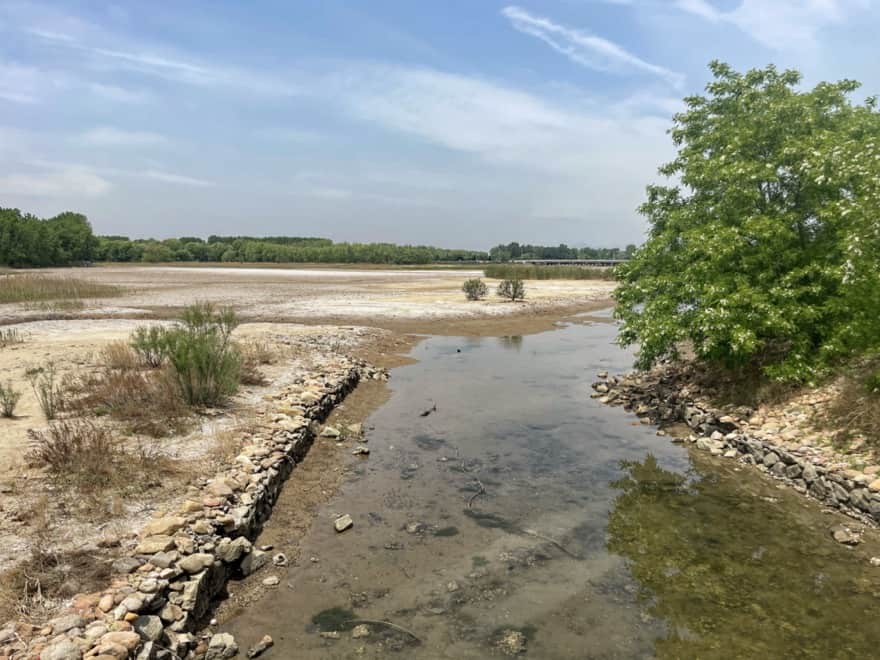
See here, photos taken along north edge of Pigeon Nest Park, May 2024. No wonder visitors see very few birds! Yes the tide is out, but even at high tide the landscaped habitat here is terrible for birds – why the steep stone-lined channel sides? Maybe to keep birds away?!!
So what should the margins of a wetland reserve look like?

Well, like this! Very gently sloping, winding muddy shorelines, maybe with small muddy islands to. This kind of habitat looks simple; and can even be created by accident – as here, at Stone River South Island, Shanhaiguan [after sand and gravel extraction I believe].
But habitats like these can also be created – and maintained – in wetland reserves, and can attract high densities of birds. At the Pigeon Nest sandflats, maybe it would be possible to create habitat like this close to the main path? – and perhaps maintain water levels partly with the help of water from the Xinhe, and/or a dirty creek.
Areas like this could attract birds year-round. And perhaps sand extracted could be used to build islands with flat tops; if these are kept clear of most vegetation other than grass, they will be used by shorebirds for roosting [resting] during high tides, and can become nesting areas for several waterbird species.

Wetland management can also involve controlling vegetation, including grass. Marshy reedbeds are an important habitat for several bird species; but also, a variety of birds prefer short grass rather than long grass – and some wetland reserves have grazing animals such as cows that help keep the grass short in some places. Here, cows are grazing at a wetland area along the Qinlong River; this stretch of the river is noted for wetland birds such as Black Stork, a locally rare breeding species.
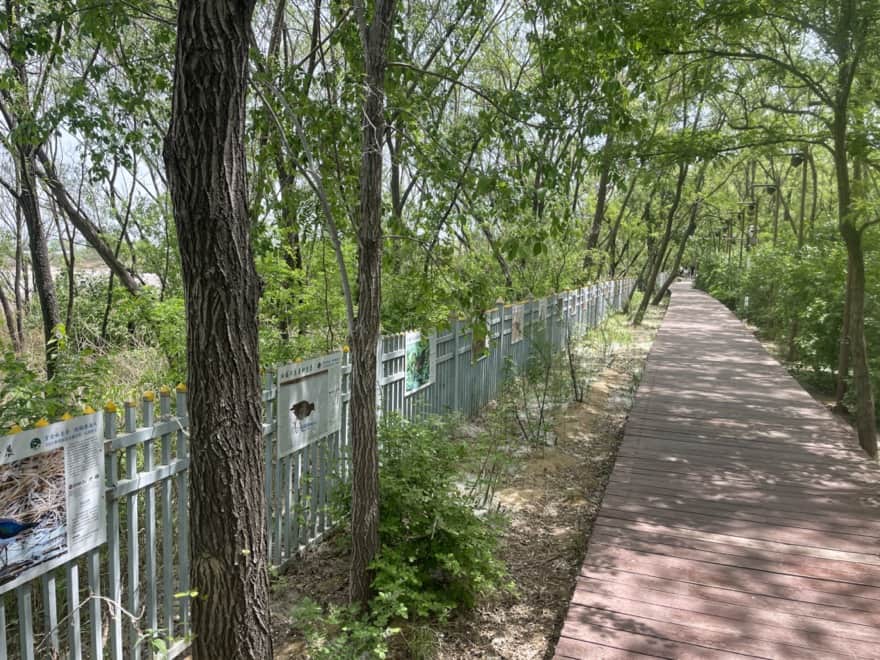
Wetland reserves typically also put considerable effort into controlling the growth of trees, which can destroy wetland habitats, speeding succession to dry land. At Pigeon Nest sandflats area, the exact opposite approach has been adopted, with many trees planted: look at this photo, and try to find the wetland!
These trees seem to be of only tiny ecological value, and there are already large areas of such trees to the north of the sandflats.
Best thing to do? Cut most of them down, especially outside the fence; restoring wetland or at least short grassland.
Ouch! That is a very painful thing to do to the natural world, isn’t it?! Well no, not when wetland should be the priority. Plus, at least some of the trees could surely be used in the reserve, such as for more natural looking fencing, incorporating into blinds.
A Possible Fabulous Future for the Pigeon Nest Park Wetland Reserve: Feeding Birds

Providing extra food is another way to attract wild birds, especially outside the breeding season. Above, a reserve staff member feeds wild swans in Britain.

Here, another reserve staff member feeds wild Red-crowned Cranes in Japan.
The birds “repay” being fed, by delighting casual visitors, along with expert birdwatchers and dedicated photographers.
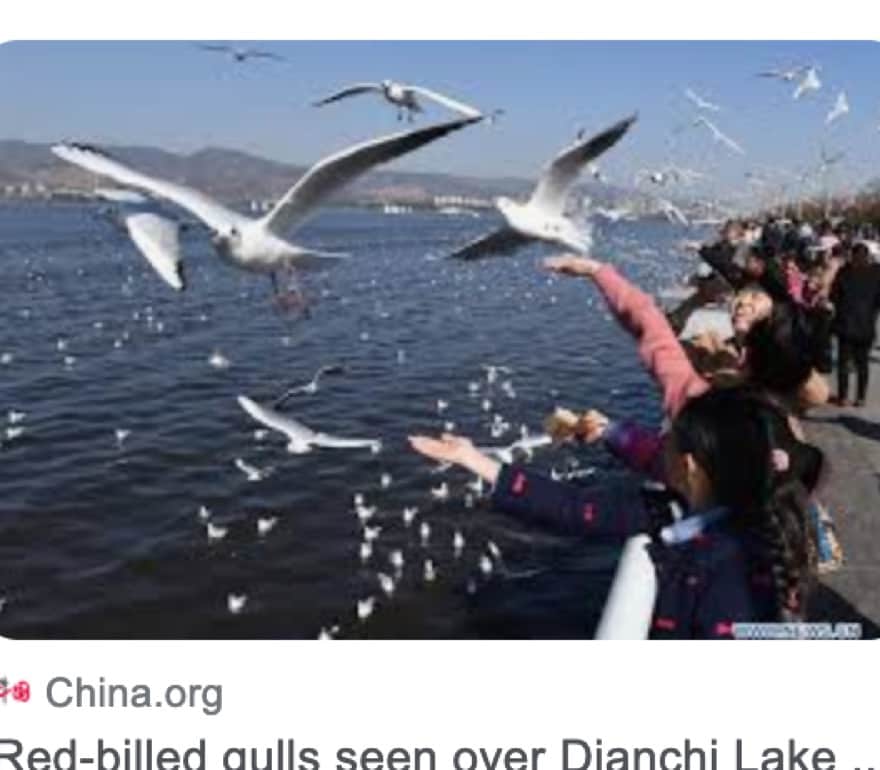
People can also really enjoy feeding birds themselves. Perhaps there could be some captive ducks and other birds in Pigeon Nest Park [not only pigeons!]; perhaps someday they will be joined by wild Mallard, as the little girl above is feeding in a British park above left.

Another Future for the Pigeon Nest Park Wetland Reserve: same same theme park style creations as can be seen almost anywhere, with barely a wild bird in sight
Of course, it’s not essential to aim high for a world-class wetland reserve.
Maybe just carry on with the same same mini theme park style areas etc etc, and continue completely ignoring the wetland and the birds.

But carrying on regardless like this will mean consigning Beidaihe’s status as a world class birdwatching hotspot to the history books. I wonder how people, including younger generations, might feel about Beidaihe becoming a has been birdwatching place, where years ago some foreigners saw many birds, and some lucky local experts also experienced rich birdlife before things went downhill? Will it be okay to just learn of these birds in history books and more; with the museum telling of what there used to be here? [And of birds that still fly over each spring and autumn, but now with less places to land, where they rest and feed.]
Lastly: staffing. Ideally, a reserve should have knowledgeable, passionate staff, who know about wildlife and habitat management; including some who can act as guides, helping and educating visitors.

All I noticed at Pigeon Nest Park were a few men whose main job seemed to be shouting through megaphones at anyone who entered the restricted area. After shouting at a woman, this guard even walked up to gulls a couple of times, and shouted at those too, as if believing they should not be in the restricted area. Not ideal behaviour for a wetland reserve!
The Wetland Park: Less Trees, More Wetland!

Above, a scene in a wetland park in Beidaihe, which holds a crane festival in autumn; with no wetland or cranes or other wetland birds in view.

Above right, a scene at a North American reserve, also holding a crane festival, with many cranes in view.

So for the Wetland Park, a very obvious way of improving the wetland habitat: cut down all or most trees. There are still many many trees to the north, on land stretching almost to Qinhuangdao city.
So do I hate trees? Of course not; trees are vital, and wonderful, in the right places.
Lianfeng Shan = The Lotus Hills: More Tree Species, Better Biodiversity
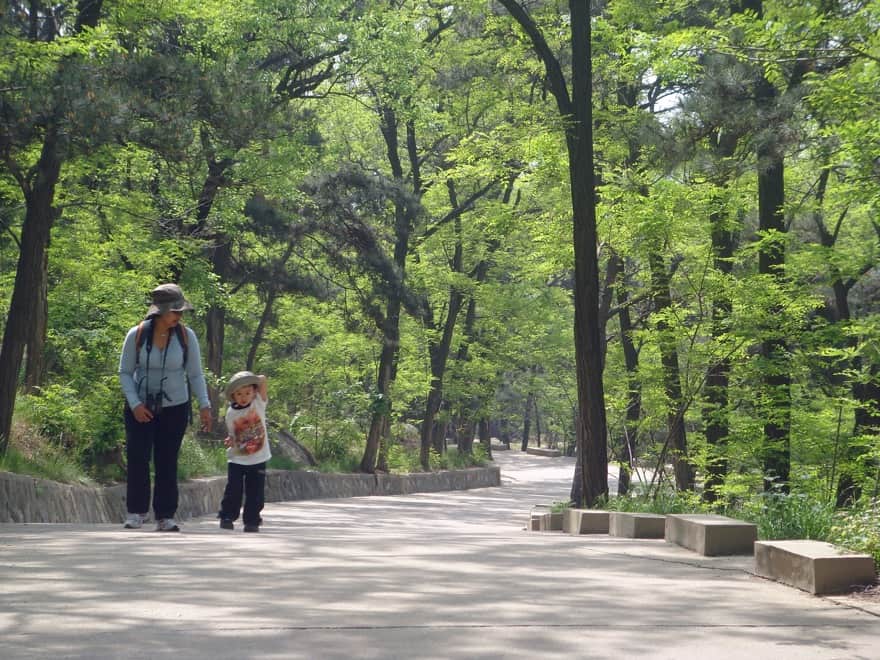
The woodland on the Lotus Hills [Lianfeng Shan] looks attractive, yet is artificial, resulting from planting early last century. There are very few main tree species and this, plus collection of wood for fuel in autumn, and poor soils with badly eroded gullies, results in low biodiversity.
Songbird migrants do occur, but few bird species breed. Compare Zu Shan, with far more breeding birds; plus a lot more tree diversity, surely with a variety of naturally growing, native trees.
It has also been decades since I first suggested planting more tree species here. These would increase biodiversity, including birds; but would also look more attractive, especially with autumn colours. Plus, better biodiversity could benefit the soil, reduce issues with pests; and just possibly reduce fire risk [also consider creating fire breaks?].
Maybe even establish an arboretum, a botanical garden dedicated to Hebei tree species and other plants, allowing it to grow as wild as possible. Glorious!


